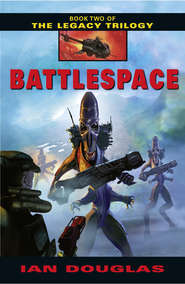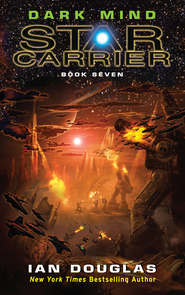По всем вопросам обращайтесь на: info@litportal.ru
(©) 2003-2024.
✖
The Star Carrier Series Books 1-3: Earth Strike, Centre of Gravity, Singularity
Настройки чтения
Размер шрифта
Высота строк
Поля
Something struck the Gallagher amidships, a hammerblow jolting the ship hard enough to snap internal struts and braces. Shields collapsed as power feeds were broken, and a large chunk of the ship’s aft section ripped free, sending the rest of the destroyer into an out-of-control tumble.
In the tactical display, bright white, expanding spheres of light marked the deaths of the Jianghua and the Hatakaze. The icons representing both the John Paul Johns and the Godavari were flashing on and off rapidly, indicating serious damage. There wasn’t even time to determine just what had hit them. Things were happening far too fast.
The scanners stayed on-line long enough for Lederer, pinned to his couch by sudden centripetal acceleration, to glimpse the odd mixed blue and pink hues of Triton as the moon flashed past less than five thousand kilometers away. Seborg’s calculations had been uncannily precise.
Then the scanners went down, as did the last of the shields.
Lederer heard the roar of escaping atmosphere as the tumbling ship continued to come apart. “Comm! Are we still transmitting?”
“Yes, sir!” Her reply seemed muted in the fast-dropping pressure of the bridge.
“All hands, this is the captain! Abandon ship! Repeat, abandon ship!”
He already knew that most of them would never make it to the life pods. Even if they did, the chances of being picked up this far out, moving this fast, were next to nill.
But if their automated scanners had picked up the enemy’s positions and orbits, and if that data had been transmitted to Earth, then Gallagher and her sister High Guard ships had successfully accomplished their mission.
It was, Lederer thought, a fitting epitaph for ships and crews alike.
CIC, TC/USNA CVS America
Mars Synchorbit, Sol System
0258 hours, TFT
Koenig had made it on board the America just in time. The ship was already casting off its magnetic grapples, and only a single passenger tube remained connecting the vessel’s spine with the dock facility. Koenig had boarded a gravtube for the ten-minute trip to the dock, then elbowed his way on board along with hundreds of other personnel returning from liberty. An enlisted rating had volunteered to serve as his personal shoehorn, pulling his way along the microgravity passageway bellowing “Gangway! Make a hole! Admiral coming through!”
Pulling himself into the hub accessway, he made his way hand-over-hand to the command deck, the bridge and CIC tucked in along the spine close behind America’s shield.
Quintanilla was waiting for him in CIC, reclining in his seat, watching the painfully slow movement of ships in the tactical display. “We have our orders from the Military Directorate,” the man said. “The fleet is to take up a holding position between Earth and Mars until we know what the enemy plans to do.”
“Get the fuck out of my seat,” Koenig replied.
“I was just—”
“You were just about to get yourself ejected from my CIC again,” Koenig growled. Technically, he’d not yet had that morning meeting with the Board of Inquiry, and wasn’t supposed to know yet that he’d been cleared. He wondered if Quintanilla knew.
Quintanilla looked as though he were about to argue, but then evidently thought better of it. Koenig was tired, recently woken from too little sleep, and obviously was in no mood for back talk.
“Welcome aboard, Admiral,” Buchanan told him from the bridge.
“Situation?” Koenig demanded.
“America is ready to cast off. We’re just taking the last few liberty personnel back on board. Zero-point fields running and tuned, ready to deliver at one hundred percent.”
“Very well. Commander Craig? Battlegroup status.”
“The battlegroup is forming up and preparing for boost,” Craig replied. “Symmons, Puller, Doyle, Milton, and Kinkaid have already cast off and are maneuvering clear of the dock area. Ticonderoga reports readiness to depart. California, Andreyev, Arkansas, and Wyecoff all report ready for release from dock. Saskatchewan reports they will be ready for release in five minutes. Battlegroup orders have been received and are awaiting your acknowledgement.”
“Thank you.”
Placing his palm over the through-put circuitry on the arm of his recliner, Koenig opened a window in his head and mindclicked the orders icon. There were two sets of orders, in fact, one from the Senate Military Directorate, and one from Admiral John C. Caruthers on the Joint Chiefs of Staff. As Quintanilla had told him, the Directorate was ordering all Confederation ships to rendezvous at a single point roughly midway between Earth and Mars, designated Solar One. At their current points in their orbits around the sun, Mars was roughly at the eleven-o’clock position, Earth at seven o’clock, Solar One at nine, and with Neptune in the direction of nine o’clock, thirty astronomical units out.
The orders from Caruthers, however, offered a little more leeway. “The body of the Confederation fleet is to rendezvous at Solar One,” the recording said, “until we are certain of the enemy’s attack path into the Inner System. When all fleet elements are assembled and at full combat readiness, they will proceed to move out-system in order to intercept the enemy as far from Sol as possible. Minor fleet elements will be deployed to forward positions to monitor and confirm the enemy’s approach. …”
Koenig had his own ideas on the matter.
No one in the Confederation could be said to be a true expert on Turusch tactics or combat doctrine. Only two people even approached that description—Admiral Karyn Mendelson, who’d commanded the Confederation fleet at Arcturus last year …
… and Koenig himself, after the Battle of Eta Boötis.
Karyn had been reassigned to Henderson’s command staff after Arcturus—not as punishment, exactly, but it certainly couldn’t be called a reward. With the carrier Hornet crippled and nearly destroyed at Arcturus, she’d been yanked from her position as CO of Battlegroup Hornet and given the new assignment at Confederation Fleet Headquarters, jockeying virtual departments, AI simulations and data download archives.
His pillow talk with Karyn last night had been about Turusch tactics, comparing the battle at Arcturus with Eta Boötis, and especially discussing what Koenig felt might be a key weakness that Confederation forces could exploit.
They were conservative.
Not in a political sense, of course. But the Turusch, even when they possessed overwhelming superiority of numbers and fleet tonnage, as had been the case both at Arcturus and at Eta Boötis, tended move slowly and they tended to be careful not to overextend themselves. At Eta Boötis, the asteroid ship—likely the enemy’s command vessel or flagship—had withdrawn as soon as it came under direct threat, even though the rest of the Turusch fleet seemed to be winning, and the rest of the fleet had retreated as well. Koenig hadn’t understood what the Turusch had been doing at the time, but he thought he saw their reasoning now. They tended to take the long view, conserving forces, avoiding unnecessary damage, and where possible, outwaiting the enemy.
In fact, it was possible that the Sh’daar were actually running the show … and that implied an even greater conservatism. If it was true that the mysterious Sh’daar had been around for half a billion years, they, likely, would be even more loath to make a hasty move or a snap judgment. The fact that fifty-five years had passed between the first human contact with the Spiders and the Sh’daar Ultimatum seemed to confirm that guess. The Sh’daar were cautious, moving slowly, taking their time to decide the best course, and taking no chances.
The Senate Military Directorate was playing it cautious as well, it seemed. By holding the majority of the Confederation fleet at Solar One, they would be in a position to move to either Mars or Earth once the Turusch approach path was known with precision. Admiral Caruthers would be planning a defensive fight; the Senate would be urging him to keep the fleet close to Earth, and not to take chances.
The problem was that if the Sh’daar/Turusch warfleet had decided to attack the Sol System, they would be coming in “loaded for bear”—an extinct mammal, Koenig gathered, that had been massive, extremely fierce, and hard to kill. In fact …
Koenig’s brow wrinkled as he took another look at the tactical updates. The display still showed thirty-three Turusch ships at an emergence point within the constellation Pisces. Neptune, currently, was in Taurus, some 30 degrees further east.
A number of things were not adding up.
The presumed initial destination of the enemy fleet, of course, was Neptune. The Confederation base on Triton had been destroyed five hours ago. By now, the High Guard ships that had helped pass the word of the initial attack would have reached Neptune; their report—if they survived to make one—would not reach Earth for another three and a half hours.
Until then, the presumption was that the enemy fleet was at Neptune … but it was a presumption that bothered Koenig.
For one thing, there were far too few ships out there. The Turusch had mustered more than fifty ships for the attack on Eta Boötis, and that was for the bombardment of a small and lightly defended base. They wouldn’t have known going in that the Marines were there waiting for them, or that Battlegroup America would show up three weeks later.
Now they were, presumably, launching an assault on the human homeworld, a star system certain to possess numerous bases, colonies, and planetary defense systems.
And they only sent thirty-three ships?
Something was very seriously wrong with the tactical picture.
“Admiral?” Buchanan’s voice asked, interrupting his thoughts. “All personnel are on board, except for a few who were taking liberty on Earth. We are ready to cast off.”
“Do it,” Koenig replied, distracted. He noted the time: 0308 hours.
“Aye, aye, sir. Helm! Maneuvering thrusters! Take us clear of the dock.”
Koenig felt the faint shudder as magnetic grapples released. The microgravity of CIC was momentarily interrupted by a hard nudge—the maneuvering thrusters firing to ease the kilometer-long star carrier clear. The external view displayed across CIC’s curving bulkheads showed the close-knit crisscross of struts and girders in the space dock gantry that now were receding at twenty meters per second.











